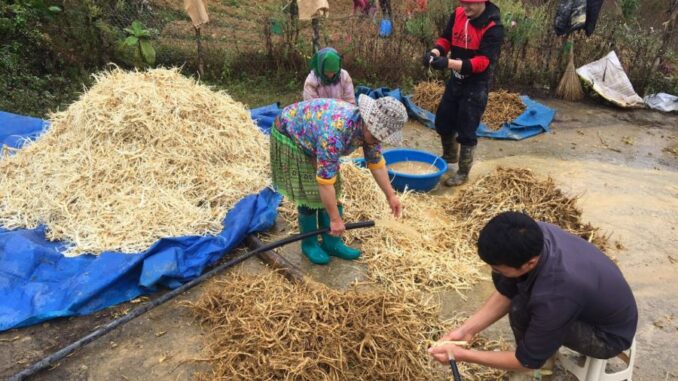
LAO CAI – Each Hmong family in the Bac Ha district grows about 0.5 hectares of sand dunes, earning 100-120 million VND per year, 6-7 times higher than that of rice and maize.

The valley of 10 hectares of sand wings in Lung Than commune, Bac Ha district, is in full bloom. At an altitude of more than 1,000 m above sea level, sand wing is the new herbal plant of this land. Each hectare gives about 8 tons of fresh tubers, the selling price is 22,000 VND/kg of tubers.
Bac Ha district has experimented with nearly 30 medicinal herbs, but only Canh Canh is considered the most successful. Ms. Chu Thi Duong, Vice President of the district, said that the tree was planted in 2015, at first only 12 hectares. Five years later, the area increased to 70 hectares, this year alone decreased to 50 hectares. “In the coming time, the tree area will increase to about 200 hectares, because the district has signed offtake contracts with many pharmaceutical companies,” Ms. Duong said.

Medicinal plant growers are mainly Mong people, cultivating on steep mountain slopes. Households plant part of the sand wing, part of corn and rice.
“Growing about half a hectare of corn and rice, each family earns 10-20 million dong/year, while sand wing earns 120 million dong/year,” said Nguyen Xuan Giang, Head of the Agriculture and Rural Development Department of Bac district. Ha, said.

Every year from September to October is the time of sowing seeds, the soil is plowed, exposed to kill insects and weeds, then limed, harrowed 10-20 cm deep, raised beds 30-35 cm high. People then fertilize the beds and then use nylon membranes to cover the beds to prevent weeds. Perforated nylon for plants to grow, one tree per hole, 5-6 kg of seeds per hectare.
Trees are planted along the mountains, intermingled with fruit trees or peppers, and tomatoes to take advantage of loose nutrients from the soil.

Sand wings are about 50-90 cm high, flowers grow in sparse flowers at the tips of branches or grow individually, white or purple-blue. The fruit has many small, dark brown seeds. Roots grow into tubers.

The family of Ms. Sung Thi Sa, 27 years old, in Ta Van Chu commune, grows 0.5 ha of sand wing, earning from 100 to 120 million VND per year. Previously, Sa spent nearly 7 million VND to go to China to grow vegetables for a living. After getting married and giving birth in the countryside, Sa stayed at home to grow sand wings.

Mr. Hoang Ao, 32 years old, Ta Van Chu commune, next to a green sandy field. The Ao family grows nearly a hectare and thanks to medicinal plants the family can buy a new motorbike and television. “Before growing corn, I never thought I would earn hundreds of millions of dong a year,” said Ao as he harvested ripe tomatoes interspersed in beds of sandalwood.

The sand dunes do not have to be watered and have few pests and diseases, but people have to weed them regularly. To clean the grass for half a hectare of sand, Ms. Sung Thi Cuc’s family had to mobilize 6 people.

November every year is the time to harvest the tubers, depending on the area, the harvesting time lasts 2-3 days. This is the raw material for the extraction of many drugs for the pharmaceutical industry.
According to oriental medicine, the tuber has the effect of curing sore throat, cough with phlegm, congestion or hoarseness…

Each hectare of land planted with sand dunes yields one ton of dried tubers. After harvesting, people will wash them and sell them to collectors to dry and sell to pharmaceutical companies.

Currently, sand wings are not only sold to pharmaceutical companies, but the blooming season here also attracts many tourists to take pictures. The garden owner charges a fee of 20,000 per person.
After 7 years of planting sandalwood, the Bac Ha district now stops supporting, and letting people own the planting area. Because it is a medicinal plant, it is grown naturally, without the use of pesticides or stimulants.
Ms. Chu Thi Duong, vice chairwoman of the Bac Ha district, said that thanks to the sand, the number of people who have to work far away has decreased by several hundred. The whole district has more than 20,000 people of working age, of which 5,000 are working far away.
